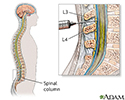Cerebrospinal fluid (CSF) culture
Culture - CSF; Spinal fluid culture; CSF cultureA cerebrospinal fluid (CSF) culture is a lab test to look for bacteria, fungi, and viruses in the fluid that moves in the space around the spinal cord. CSF protects the brain and spinal cord from injury.
How the Test is Performed
A sample of CSF is needed. This is usually done with a lumbar puncture (also known as a spinal tap).
Spinal tap
Cerebrospinal fluid (CSF) collection is a test to look at the fluid that surrounds the brain and spinal cord. CSF acts as a cushion, protecting the b...

The sample is sent to the lab. There, it is placed in a dish that has a special substance called a culture medium. Lab staff then observe if bacteria, fungi, or viruses grow in the dish. Growth means there is an infection.
How to Prepare for the Test
Follow instructions on how to prepare for a spinal tap.
Why the Test is Performed
Your health care provider may order this test if you have signs of an infection that affects the brain or nervous system. The test helps identify what is causing the infection. This will help your provider decide on the best treatment.
Normal Results
A normal result means no bacteria, viruses, or fungi grew in the lab dish. This is called a negative result. However, a normal result doesn't mean there is no infection. The spinal tap and CSF smear may need to be done again.
What Abnormal Results Mean
Bacteria or other germs found in the sample may be a sign of meningitis. This is an infection of the membranes covering the brain and spinal cord. The infection can be caused by bacteria, fungi, or viruses.
Meningitis
Meningitis is an infection of the membranes covering the brain and spinal cord. This covering is called the meninges.

Risks
A lab culture poses no risk to you. Your provider will tell you about the risks of a spinal tap.
References
Hasbun R, Tunkel AR. Approach to the patient with central nervous system infection. In: Bennett JE, Dolin R, Blaser MJ, eds. Mandell, Douglas, and Bennett's Principles and Practice of Infectious Diseases. 9th ed. Philadelphia, PA: Elsevier; 2020:chap 86.
Karcher DS, McPherson RA. Cerebrospinal, synovial, serous body fluids, and alternative specimens. In: McPherson RA, Pincus MR, eds. Henry's Clinical Diagnosis and Management by Laboratory Methods. 24th ed. Philadelphia, PA: Elsevier; 2022:chap 30.
O'Connell TX. Cerebrospinal fluid evaluation. In: O'Connell TX, ed. Instant Work-Ups: A Clinical Guide to Medicine. 2nd ed. Philadelphia, PA: Elsevier; 2017:chap 9.
-
Pneumococci organism - illustration
This picture shows the organism Pneumococci. These bacteria are usually paired (diplococci) or appear in chains. Pneumococci are typically associated with pneumonia, but may cause infection in other organs such as the brain (pneumococcal meningitis) and blood stream (pneumococcal septicemia). (Image courtesy of the Centers for Disease Control and Prevention)
Pneumococci organism
illustration
-
CSF smear - illustration
Cerebral spinal fluid (CSF) is a clear fluid that circulates in the space surrounding the spinal cord and brain. CSF protects the brain and spinal cord from injury by acting like a liquid cushion. CSF is usually obtained through a lumbar puncture (spinal tap). During the procedure, a needle is inserted usually between the 3rd and 4th lumbar vertebrae and the CSF fluid is collected for testing.
CSF smear
illustration
-
Pneumococci organism - illustration
This picture shows the organism Pneumococci. These bacteria are usually paired (diplococci) or appear in chains. Pneumococci are typically associated with pneumonia, but may cause infection in other organs such as the brain (pneumococcal meningitis) and blood stream (pneumococcal septicemia). (Image courtesy of the Centers for Disease Control and Prevention)
Pneumococci organism
illustration
-
CSF smear - illustration
Cerebral spinal fluid (CSF) is a clear fluid that circulates in the space surrounding the spinal cord and brain. CSF protects the brain and spinal cord from injury by acting like a liquid cushion. CSF is usually obtained through a lumbar puncture (spinal tap). During the procedure, a needle is inserted usually between the 3rd and 4th lumbar vertebrae and the CSF fluid is collected for testing.
CSF smear
illustration
Review Date: 8/29/2024
Reviewed By: Jatin M. Vyas, MD, PhD, Roy and Diana Vagelos Professor in Medicine, Columbia University Vagelos College of Physicians and Surgeons, Division of Infectious Diseases, Department of Medicine, New York, NY. Also reviewed by David C. Dugdale, MD, Medical Director, Brenda Conaway, Editorial Director, and the A.D.A.M. Editorial team.



